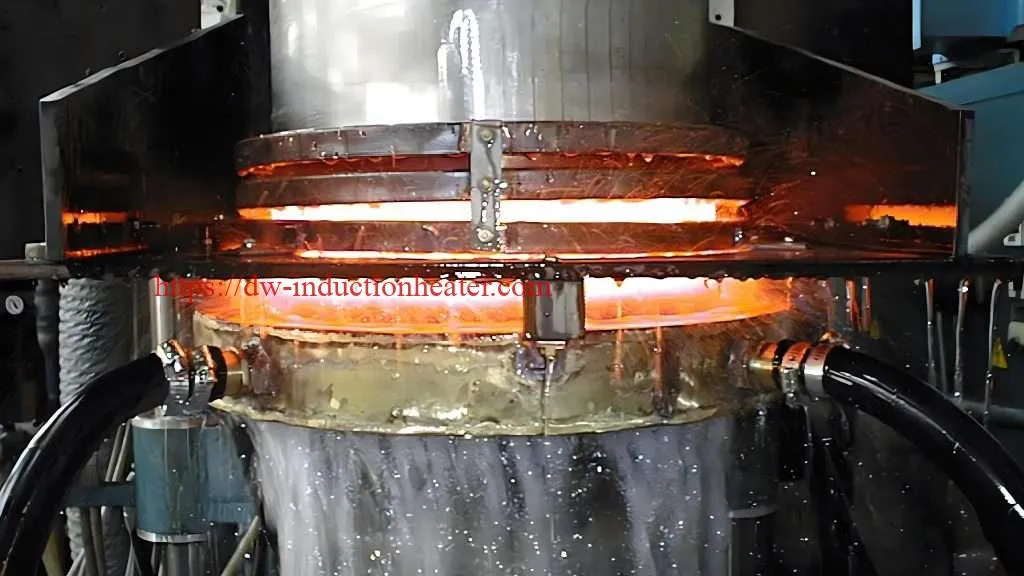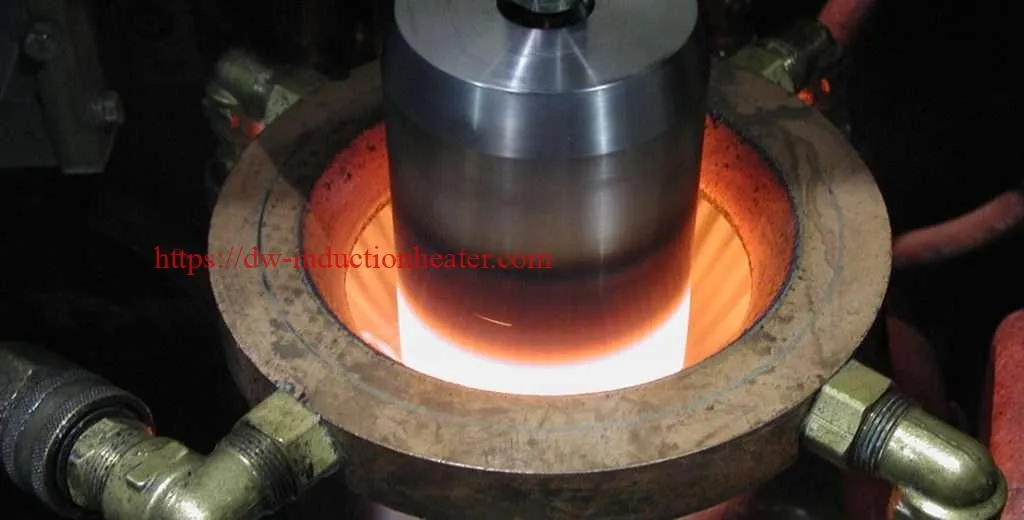Induction Hardening: Maximizing Surface Hardness and Wear Resistance
What is Induction Hardening?
The Principles Behind Induction Hardening
Electromagnetic Induction
Induction hardening is a heat treatment process that selectively hardens the surface of metal components by utilizing the principles of electromagnetic induction. This process involves passing a high-frequency alternating current through an induction coil placed around the component, generating a powerful electromagnetic field. As the electromagnetic field interacts with the conductive material, it induces electrical currents within the component, causing rapid and localized heating of the surface.
Rapid Heating and Quenching
The induced currents generate heat within the component’s surface, raising its temperature to the austenitic range (typically between 800°C and 950°C for steel). Once the desired temperature is reached, the component is immediately quenched, typically by spraying or immersing it in a quenching medium, such as water, oil, or a polymer solution. The rapid cooling causes the austenite to transform into martensite, a hard and wear-resistant microstructure, resulting in a hardened surface layer.
Advantages of Induction Hardening
Increased Surface Hardness and Wear Resistance
One of the primary advantages of induction hardening is the ability to achieve exceptional surface hardness and wear resistance. The martensitic microstructure formed during the quenching process can result in surface hardness values exceeding 60 HRC (Rockwell Hardness Scale C). This high hardness translates to improved wear resistance, making induction-hardened components ideal for applications involving sliding, rolling, or impact loads.
Precise and Localized Hardening
Induction hardening allows for precise and localized hardening of specific areas on a component. By carefully designing the induction coil and controlling the heating pattern, manufacturers can selectively harden critical regions while leaving other areas unaffected. This capability is particularly valuable in applications where only certain sections of a component require enhanced hardness and wear resistance, such as gear teeth, cam lobes, or bearing surfaces.
Energy Efficiency
Compared to other heat treatment processes, induction hardening is highly energy-efficient. The induction coil directly heats the component’s surface, minimizing energy losses associated with heating the entire component or furnace. Additionally, the rapid heating and cooling cycles contribute to energy savings, making induction hardening an environmentally friendly and cost-effective process.
Versatility and Flexibility
Induction hardening is a versatile process that can be applied to a wide range of materials, including various grades of steel, cast iron, and certain non-ferrous alloys. It is also suitable for components of different shapes and sizes, from small gears and bearings to large shafts and cylinders. The flexibility of induction hardening allows manufacturers to tailor the process parameters to meet specific requirements, ensuring optimal hardness and performance.
Applications of Induction Hardening
Automotive Industry
The automotive industry is a major consumer of induction-hardened components. Gears, crankshafts, camshafts, bearings, and other critical drivetrain components are commonly induction-hardened to withstand the high loads and wear encountered in automotive applications. Induction hardening plays a crucial role in enhancing the durability and reliability of these components, contributing to improved vehicle performance and longevity.
Aerospace Industry
In the aerospace industry, where safety and reliability are paramount, induction hardening is widely employed for critical components such as landing gear components, turbine blades, and bearings. The high hardness and wear resistance achieved through induction hardening ensure these components can withstand extreme operating conditions, including high temperatures, loads, and vibrations.
Manufacturing and Industrial Machinery
Induction hardening finds extensive applications in the manufacturing and industrial machinery sectors. Components such as gears, shafts, rollers, and cutting tools are often induction-hardened to improve their service life and performance. This process helps reduce downtime, maintenance costs, and replacement frequencies, ultimately enhancing productivity and efficiency in industrial operations.
Tooling and Mold Making
In the tooling and mold-making industries, induction hardening is crucial for producing durable and long-lasting tools and molds. Dies, punches, forming tools, and injection molds are commonly induction-hardened to resist wear, abrasion, and deformation during demanding manufacturing processes involving high pressures, temperatures, and repetitive cycles.
The Induction Hardening Process
Surface Preparation
Proper surface preparation is essential for successful induction hardening. The component’s surface must be clean and free from contaminants, such as oil, grease, or scale, as these can interfere with the heating and quenching processes. Common surface preparation techniques include degreasing, shot blasting, or chemical cleaning methods.
Induction Coil Design and Selection
Coil Configuration
The design and configuration of the induction coil play a crucial role in achieving the desired heating pattern and hardness profile. Coils can be customized to match the shape and size of the component, ensuring efficient and uniform heating. Common coil configurations include helical coils for cylindrical components, pancake coils for flat surfaces, and customized coils for complex geometries.
Coil Material and Insulation
The coil material and insulation are carefully selected based on the operating temperatures and frequencies involved. Copper or copper alloys are commonly used for their high electrical conductivity, while insulating materials like ceramic or refractory materials protect the coil from high temperatures and prevent electrical breakdown.
Heating and Quenching
Temperature Control and Monitoring
Precise temperature control and monitoring are essential during the induction hardening process to ensure the desired hardness and microstructure are achieved. Temperature sensors, such as thermocouples or pyrometers, are used to monitor the component’s surface temperature in real-time. Advanced control systems and feedback loops help maintain the desired temperature profile throughout the heating cycle.
Quenching Methods
After the component reaches the target temperature, it is rapidly quenched to form the martensitic microstructure. Quenching methods can vary depending on the component’s size, shape, and material. Common quenching techniques include spray quenching, immersion quenching (in water, oil, or polymer solutions), and specialized quenching systems like high-pressure or cryogenic quenching.
Quality Control and Inspection
Hardness Testing
Hardness testing is a crucial step in verifying the effectiveness of the induction hardening process. Various hardness testing methods, such as Rockwell, Vickers, or Brinell tests, are employed to measure the surface hardness of the component and ensure it meets the specified requirements.
Microstructural Examination
Microstructural examination involves analyzing the component’s surface and subsurface microstructure using techniques like optical microscopy or scanning electron microscopy (SEM). This analysis helps confirm the presence of the desired martensitic microstructure and identify any potential issues, such as incomplete transformation or non-uniform hardening.
Non-Destructive Testing
Non-destructive testing (NDT) methods, such as ultrasonic testing, magnetic particle inspection, or eddy current testing, are often employed to detect subsurface defects, cracks, or inconsistencies in the hardened layer. These techniques provide valuable information about the component’s integrity and quality without causing any damage.
Conclusion
Induction hardening is a highly effective and efficient process for maximizing surface hardness and wear resistance in metal components. By leveraging the principles of electromagnetic induction and rapid heating and quenching, this process creates a hardened martensitic surface layer that offers exceptional durability and resistance to wear, abrasion, and impact.
The versatility of induction hardening allows it to be applied across various industries, including automotive, aerospace, manufacturing, and tooling, where enhanced surface properties are crucial for component performance and longevity. With its precise and localized hardening capabilities, energy efficiency, and flexibility, induction hardening continues to be a preferred choice for manufacturers seeking to optimize the performance and reliability of their products.
As technology advances, the induction hardening process continues to evolve, with improvements in coil design, temperature control, and quenching methods, ensuring even better hardness profiles and surface quality. By combining advanced materials, process control, and quality assurance techniques, induction hardening remains a vital tool in the pursuit of maximizing surface hardness and wear resistance for critical components across various industries.
FAQ: Frequently Asked Questions
- What materials are suitable for induction hardening? Induction hardening is primarily used for ferrous materials, such as various grades of steel and cast iron. However, certain non-ferrous alloys, like nickel-based or cobalt-based alloys, can also be induction-hardened under specific conditions.
- How deep can the hardened layer be achieved through induction hardening? The depth of the hardened layer depends on several factors, including the component’s material, the induction coil design, and the process parameters. Typically, induction hardening can achieve hardened case depths ranging from 0.5 mm to 10 mm, with deeper case depths possible in certain applications.
- Can induction hardening be applied to complex component geometries? Yes, induction hardening can be applied to components with complex geometries. Specialized induction coils can be designed and customized to accommodate intricate shapes, allowing for precise and localized hardening of specific areas.
- What are the typical quenching media used in induction hardening? Common quenching media used in induction hardening include water, oil, and polymer solutions. The choice of quenching medium depends on factors such as the component’s material, size, and desired cooling rate. Specialized quenching systems, like high-pressure or cryogenic quenching, may also be employed for specific applications.
- How does induction hardening compare to other hardening processes in terms of environmental impact? Induction hardening is generally considered an environmentally friendly process due to its energy efficiency and minimal waste generation. Compared to traditional furnace-based hardening processes, induction hardening consumes less energy and produces lower emissions, making it a more sustainable choice for heat treatment operations.
